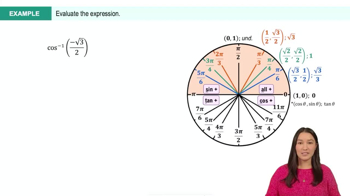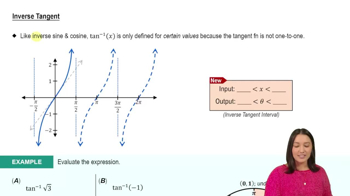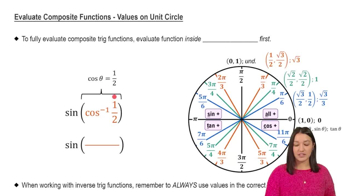Table of contents
- 0. Functions7h 52m
- Introduction to Functions16m
- Piecewise Functions10m
- Properties of Functions9m
- Common Functions1h 8m
- Transformations5m
- Combining Functions27m
- Exponent rules32m
- Exponential Functions28m
- Logarithmic Functions24m
- Properties of Logarithms34m
- Exponential & Logarithmic Equations35m
- Introduction to Trigonometric Functions38m
- Graphs of Trigonometric Functions44m
- Trigonometric Identities47m
- Inverse Trigonometric Functions48m
- 1. Limits and Continuity2h 2m
- 2. Intro to Derivatives1h 33m
- 3. Techniques of Differentiation3h 18m
- 4. Applications of Derivatives2h 38m
- 5. Graphical Applications of Derivatives6h 2m
- 6. Derivatives of Inverse, Exponential, & Logarithmic Functions2h 37m
- 7. Antiderivatives & Indefinite Integrals1h 26m
- 8. Definite Integrals3h 25m
0. Functions
Inverse Trigonometric Functions
Problem 51
Textbook Question
Verify the identity sec⁻¹ x = cos⁻¹ (1/x), for x ≠ 0.
 Verified step by step guidance
Verified step by step guidance1
Start by recalling the definitions of the inverse secant and inverse cosine functions: sec⁻¹(x) is the angle θ such that sec(θ) = x, and cos⁻¹(y) is the angle φ such that cos(φ) = y.
Express sec(θ) in terms of cos(θ): since sec(θ) = 1/cos(θ), we can rewrite the equation sec(θ) = x as 1/cos(θ) = x.
Rearrange the equation to find cos(θ): multiply both sides by cos(θ) to get 1 = x * cos(θ), which leads to cos(θ) = 1/x.
Now, relate θ to φ: since cos(φ) = 1/x, we can say that φ = cos⁻¹(1/x).
Finally, since both θ and φ represent the same angle in terms of their definitions, we conclude that sec⁻¹(x) = cos⁻¹(1/x).
Recommended similar problem, with video answer:
 Verified Solution
Verified SolutionThis video solution was recommended by our tutors as helpful for the problem above
Video duration:
3mPlay a video:
Was this helpful?
Related Videos
Related Practice













